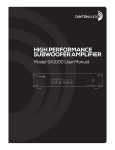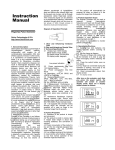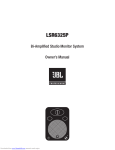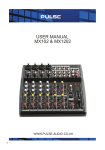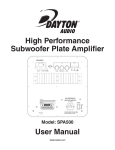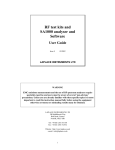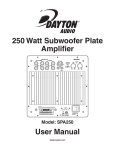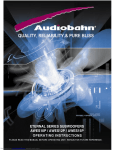Download User's Manual High Performance Subwoofer Amplifier
Transcript
High Performance Subwoofer Amplifier Model: SA1000 User's Manual daytonaudio.com Thank you for purchasing the Dayton Audio® SA1000 subwoofer amplifier, one of the most versatile and powerful subwoofer amplifiers available. The tabletop or rack-mountable design is perfect for high-end home theater installations or DIY subwoofer projects. The SA1000 has the power to drive even the most power-hungry subwoofer systems. FEATURES: • High pass output for looping signal back into distributed audio systems • Can be easily converted between rack-mount and tabletop configurations • Heavy-duty steel chassis with brushed aluminum faceplate • Adjustable phase, gain, crossover, and parametric EQ • Pop-out adjustment knobs keep settings from being easily disturbed • Switchable 110/220V input voltage • Patented tracking downconverter power supply for high efficiency • Class AB output stage for clean, controlled output • Low frequency parametric EQ allows you to boost or cut to custom-tailor the sound • Advanced soft clip circuitry improves headroom and protects woofers • Manual, auto, or triggered on/off for integration into any automated system • Switchable subsonic and bass boost filters INSTALLATION: The SA1000 is designed to provide high fidelity subwoofer amplification and is tailored for home audio, home theater, and studio environments. It is not recommended for use in DJ, pro-sound, or other high-duty-cycle applications. For home audio tabletop applications, use the unit as it comes out of the box with the rubber feet and without the rack ears. In a custom home theater or studio where rack mounting is available, simply remove the rubber feet and attach the included rack ears. The amplifier runs cool thanks to its high efficiency, but care should be taken to leave some room for air circulation above the amplifier. Stacked components that utilize rubber or plastic feet should provide adequate clearance in most situations. FRONT PANEL: 4. Phase Adjustable phase compensation from 0 to 180 degrees. Helps the user correct improper phasing of the main speakers or differing listening distances between the subwoofer and mains, which can cause a poor acoustic summation around the crossover point. In most situations the knob should be left at 0 degrees, but for the advanced user it can be set either by ear or with the aid of measurement instruments. 1. Power Switch / Indicator LED Front panel pushbutton power switch turns the amplifier on and off. When the indicator LED is lit dimly, the amplifier is in standby mode. When the LED is lit brightly, the amplifier is fully active. 2. Gain Sets the overall level of the amplifier, used to match the output of the subwoofer to the rest of the speakers in the system. 5. EQ The EQ adjustment knobs enable the user to custom-tailor one band of parametric equalization for their subwoofer, which can be used to add boost to the low-end of the response, or can be used to cut out an excessively loud room resonance. The freq. knob selects the frequency for the filter, the bandwidth knob selects how wide or narrow the filter is (the higher the bandwidth, the broader the effect), and the level knob can be used to add up to 6dB of boost or 14 dB of cut. 3. Frequency Adjusts the low-pass crossover frequency from 30 Hz to 200 Hz. When using the Left/Right inputs, this adjustment will allow you to properly integrate the subwoofer with the satellite or main speakers. It is recommended to experiment with different settings until the smoothest transition between subwoofer and speakers is achieved. (2) REAR PANEL: 6. AC Power The SA1000 comes shipped standard for 110V U.S. operation; simply connect the included IEC power cord to your wall outlet. For 220V input, remove the fuse holder, rotate 180 degrees, and re-install. In most 220V applications a separate power cord will be required and is not included. 10. Bass Boost Selects a bass boost filter with +3dB @ 25Hz, Q=1.4. Allows the user to add boost to the low end response without using the built-in parametric EQ. This leaves the parametric EQ function to address room modes to cut out an excessively loud room resonance. 7. 12V Trigger Input The 12V trigger input is a handy feature when connecting the amplifier to an automated audio system. The 3.5mm mini-plug jack will accept up to a 12V DC output from another device, or from a separate power supply. When the trigger input is energized, the amp turns from standby to ON mode. When using the SA1000 with a home theater receiver without a trigger output, the voltage can come from a 12V wall wart (3.5mm tip-positive connector) plugged into the receiver’s switched outlet and the trigger input. 11. Subsonic Filter Selects a subsonic filter with -3dB @ 18Hz, Q=.8. Allows the user to remove the subsonic information from the signal and tighten the low end response of some subwoofer systems. 12. Line Inputs RCA-style jacks receive the audio signal from standard line-level audio sources. When used in a two-channel stereo system, both the left and right audio inputs should be connected and are internally summed to a mono output. The adjustable crossover is in effect when using the left or right inputs. When using an amplifier with an audio source that is mono and pre-filtered, the LFE input should be used; this bypasses the onboard low-pass crossover for more accurate reproduction of the incoming signal. 8. Speaker Outputs Speaker level output connections carry the amplified signal to the subwoofer drivers. Binding posts will accept bare wire, banana plugs, or spade plugs. Two sets of outputs are provided so multiple systems can be connected. When using both outputs the combined load must have a minimum of 4 ohms impedance! NOTE: Bass Boost and Subsonic Filters are active on both LFE and L/R inputs. 9. Remote Turn On Selects the turn-on stimuli that will put the amplifier in ready mode. “12V trigger” setting relies on voltage going into the 12V trigger input to activate the amplifier. “Auto” setting senses a signal on the RCA line-level inputs and automatically puts the amp in ready mode. “On” setting puts the amp constantly in ready mode so that it can be controlled by the master power switch on the front panel. In “Auto” mode, the amplifier will take approximately 15 minutes to turn off from ready to standby mode. 13. High Pass Output RCA-style jacks allow the line level input signal to be looped back into other audio equipment. The high pass signal utilizes a 12 dB per octave filter with an output slope of -3dB @ 80Hz. This feature is useful for connecting the signal to distributed audio systems. BASS BOOST / SUBSONIC FILTER SETTINGS Frequency Response Switch Settings (3) NOTES ABOUT HUM: While the SA1000 has been designed to minimize the possibility of hum in the subwoofer system, it is still possible that a hum will occur in rare circumstances. Its safety grounding can create a path for small amounts of 60 Hz energy to travel trough the line-level audio system. While not dangerous, this energy can cause difficulty with the subwoofer auto signal sensing circuit, and at the very least will interfere with the quiet enjoyment of your system. The first course of action should be trying to make sure that all of the audio components are connected to either the same electrical outlet, or at least into the same circuit branch. Next, cable TV systems are notoriously the culprit, so be sure to try disconnecting all coaxial feeds that are connected to the system. If this solves the problem, install a coaxial line isolator and reconnect the system. In the very worst case, a linelevel audio isolator/transformer connected to the line-in of the subwoofer amplifier will usually solve the problem. SPECIFICATIONS: Rated Power Output: Signal to Noise Ratio: Efficiency: Input Impedance: Subsonic Filter: Bass Boost: High Pass Output: Low Pass Adjustment: Phase Adjustment: (0.92 % THD) 497 Watts* into 8 ohms, 950 Watts* into 4 ohms *Based on one-third power duty cycle 98 dB A-weighted 86% 12K ohms -3dB @ 18 Hz, Q=.8 +3dB @ 25 Hz, Q=1.4 -3dB @ 80 Hz, 12dB per octive 30 Hz – 200 Hz 0° – 180° 18 Hz – 80 Hz 0.1 – 1 Q -14.5dB – +6dB Parametric EQ: Frequency: Bandwidth: Level: Dimensions: Power Requirements: Stand-by Power Rating: Weight: 17-1/2" W x 4" H x 13" D (tabletop configuration) 120/230 VAC, 50 Hz/60 Hz 120V 24W; 230V 18.4W 20 lbs. Warranty Information Dayton Audio® products are constructed by industry experts, and are thoroughly tested before shipment. Dayton Audio® products are warranted for the period of one year. This warranty is limited to manufacturer defects, either in materials or workmanship. Dayton Audio® is not responsible for any consequential on inconsequential damage to any other unit or component or the cost for installation or extraction of any component of the audio system. In the rare case of a product failure, please contact your place of purchase or call our Customer Support Department at (937) 743-8248. Warranty Limitations There are no other warranties, either express or implied, which extend the foregoing, and there are no warranties of merchantability or fitness for any particular purpose. The warranty will not cover incidental or consequential damage due to defective or improper use of products. This includes but is not limited to burnt voice coils, overheating, bent frames, holes in the cone, or broken lead wires. This warranty gives you specific legal rights and you may also have other rights which vary from state to state. Non-Warranty Service: If non-warranty service is required, the product may be sent to the Company for repair/replacement, transportation prepaid, by calling (937) 743-8248 for details, complete instructions, and service fee charges. SA-09 © 2009 Dayton Audio® (4)




